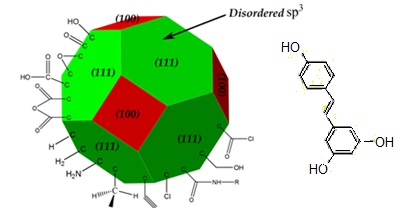2014 University of Rome Tor Vergata
"Uncovering Excellence"
Nanodiamond: a bright shuttle for molecules in the cell space
KEYWORDS: Nanodiamonds, drug delivery, photoluminescence, bioactivity

New scenarios in the design of systems for biomedical applications are now been opened by the availability of multifunctional nanomaterials that can be used to image or label biomolecules and to assist in drug delivery, making possible to define new reliable and effective strategies for theranostic approaches. Detonation nanodiamonds (DND) are carbon sp3 nanoparticles sized from 2 to 8 nm. This material not only bares the well-known bulk diamond proprieties like hardness, mechanical resistance, stiffness but also possess several unique capacities due to nanosized dimensions like: high surface area (up to 300 m2/g) and the possibility to easily manipulate the chemical groups on the surface. The peculiar surface chemistry and higher biocompatibility distinguish DND from all other carbon nanostructure. Nanodiamonds were identified as the less toxic among nanocarbons (i.e. carbon blacks, fullerenes, carbon nanotubes) in a wide variety of cell lines: they generally induced neither significant oxidative stress nor apoptosis during cell treatments (Horie et al., 2012). DND are readily internalized by the cells presumably via endocytosis and do not interfere with cells viability even at high concentrations. These promising results open the possibility to use DND as an ideal drug- shuttle for cells The coupling of DND with natural substances and their combined use in cancer therapy is proposed. To preserve biological activity of natural substances the carriers have to interact with the antioxidant preventing chemical alterations and release efficiently the active molecules into target cells. Understanding chemical interactions between drugs and DND surface is a keystone to enhance drug loading and comprehend meds releasing mechanisms in cells. The investigation of the electronic interactions between the chemical species involved (molecules, functional groups and ND) which represent a key point to understand the biological activity of such adducts, is one object of this research project.
-----------------------------------------------------------------------------------------------------
Diatoms are unicellular aquatic microalgae possessing amazing self-assembled ordered micro- and nano-porous hierarchical silica cell walls called frustules. The quasi periodic and highly regular pore patterns on the diatom surface are very attractive for applications based on optical and photonic properties of materials. Our proposed pioneering research aims to explore the multiple scattering and localization of light shown by diatom frustules in order to amplify their photoluminescence in a random laser (RL), as this technology is highly attractive for environmental monitoring, medical diagnostics and advanced packaging inspection. RL is a special type of laser in which the optical feedback is due to light scattering in an amplifying medium instead of a conventional optical cavity. The major aim will be to study a set of selected frustules with different shapes and pore patterns, obtained from diatom cultivation in large scale photobioreactors, for comparative analysis of their random lasing effect doping the bioscaffold with organic dyes having luminescence in the visible range. A multidisciplinary approach combining expertise from biology, physics and materials sciences, relying on high-resolution instrumentation and advanced algal cultivation equipment, is necessary. This will allow to go beyond our past research on RL effect in commercial diatomite and natural diatom samples and is highly prospect to inspire novel developments in photonics and materials sciences.
2014 University of Rome Tor Vergata
"Uncovering Excellence"
PHANTOM - PHotonic ApplicatioN in diaTOM frustules
KEYWORDS: Diatoms,Frustules,Photoluminescence,Dyes,Random laser,Biophotonic application
Diatoms are unicellular aquatic microalgae possessing amazing self-assembled ordered micro- and nano-porous hierarchical silica cell walls called frustules. The quasi periodic and highly regular pore patterns on the diatom surface are very attractive for applications based on optical and photonic properties of materials. Our proposed pioneering research aims to explore the multiple scattering and localization of light shown by diatom frustules in order to amplify their photoluminescence in a random laser (RL), as this technology is highly attractive for environmental monitoring, medical diagnostics and advanced packaging inspection. RL is a special type of laser in which the optical feedback is due to light scattering in an amplifying medium instead of a conventional optical cavity. The major aim will be to study a set of selected frustules with different shapes and pore patterns, obtained from diatom cultivation in large scale photobioreactors, for comparative analysis of their random lasing effect doping the bioscaffold with organic dyes having luminescence in the visible range. A multidisciplinary approach combining expertise from biology, physics and materials sciences, relying on high-resolution instrumentation and advanced algal cultivation equipment, is necessary. This will allow to go beyond our past research on RL effect in commercial diatomite and natural diatom samples and is highly prospect to inspire novel developments in photonics and materials sciences.
